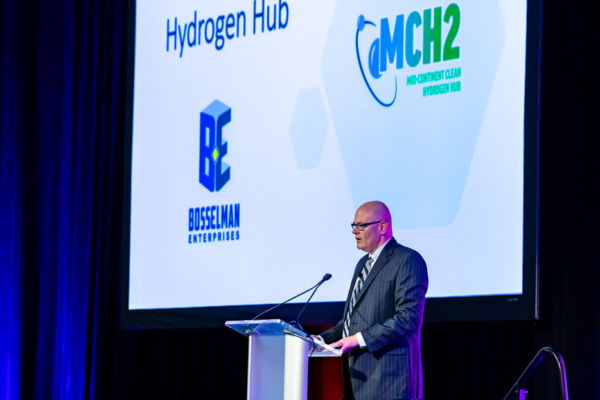Article created for the October digital issue of
States nationwide have applied for funding from the U.S. Department of Energy to construct hydrogen fueling infrastructure.
NATSO member Randy Gard, chief operating officer for Bosselman Enterprises, is an active member of the Mid-Continent Clean Hydrogen Hub, which includes Nebraska, Iowa and Missouri, and has been an active part of the Hub’s site selection process.
He shared with Stop Watch magazine about the Mid-Continent Clean Hydrogen Hub.
Mid-Continent Hydrogen Hub Identifies Possible Fueling Sites
Gard said the Mid-Continent Hydrogen Hub, also called MCH2, underwent a thorough process to identify possible fueling sites along I-80 from the Colorado border to the Iowa border and initially identified 40 potential locations.
“We sent a letter and email out to all 40 inviting them to either a phone call or in-person conversation about the Hydrogen Hub and what it means and asking if they have interest in being a possible refueling site,” Gard explained. “We eventually narrowed it down to four.”
Every potential location had to be accessible to Class 8 trucks, have existing high-flow facilities, such as diesel fuel, offer amenities truck drivers need and have truck parking. Most hydrogen fuel cell trucks will have a range of about 300 miles, so locations needed to be within that range from each other.
Hydrogen Hub Application Submission
“Once we had those four prime targets, we submitted our Hydrogen Hub application to the Department of Energy. In the next 30 days or less, the DOE is going to make some decisions about what Hydrogen Hubs they want to select for the build out of hydrogen infrastructure and where that infrastructure goes,” Gard said while speaking with NATSO on Sept. 13.
Construction, Layout, Costs and Safety Requirements
While the MCH2 waits for the DOE’s response, members of the group are engaging companies who have built hydrogen refueling locations in California to learn from their experiences regarding construction, layout, costs and safety requirements.
“If we are selected, and we’re hopeful we will be, we’ll have some clarity on costs. We can then re-engage the retailers we selected and do a layout of the facility to see where we would put it,” Gard said, adding that it may be the second half of next year before all of the funding mechanisms are put into place.
Get Involved in Hydrogen Hubs in Your Area
Gard, who also spoke about hydrogen at NATSO Connect 2023, recommends that NATSO members get involved in Hydrogen Hubs in their area. “If you’re not engaged in it, if you’re not keenly aware of the Hydrogen Hub in your area, the opportunity may pass you by and you may not be able to participate in it,” he said. “As I put it, either you have a seat at the table or you’re on the menu.”
One of the benefits of the MCH2 is the ability to collaborate with key industry stakeholders, including fleets. “On our steering committee, we have stakeholders from Werner, and they have quite a few of these trucks on order,” Gard said. “We have retailers, and it gives us a really rounded group where we can get answers to our questions and collaborate.”
Unfortunately, there isn’t a central repository for all Hydrogen Hubs that have submitted applications to the DOE. The DOE has declined to share information on applicants but said it would release more details on selected applications following the merit review process and selections announcements.
“The best way to find out who has submitted one in the state where you operate is probably to Google it until the DOE announces its decisions,” Gard explained.
Hydrogen Hubs
In addition to the Mid-Continent Clean Hydrogen Hub (Nebraska, Iowa and Missouri), other Hubs include:
Obsidian Pacific Northwest Hydrogen Hub: Oregon
Pacific Northwest Hydrogen Association: Washington
Alliance for Reliable Clean Hydrogen Energy System: California
Western Interstate Hydrogen Hub: Colorado, New Mexico, Utah and Wyoming
Southwest Clean Hydrogen Innovation Network: Arizona
Heartland Hydrogen Hub: Minnesota, Montana, North Dakota, and Wisconsin
Harvest Hydrogen: Kansas
HALO Hydrogen Hub: Louisiana, Oklahoma, Arkansas
Horizons & Trans-Permian Clean Hydrogen Hub: Texas
Greater St. Louis and Illinois Regional Clean Hydrogen: Missouri and Illinois
Great Lakes Clean Hydrogen Coalition: Ohio and Michigan
Ohio Clean Hydrogen Hub Alliance: Ohio
Southeast Hydrogen Hub: Alabama, Georgia, Kentucky, North Carolina, South Carolina and Tennessee
Mississippi Clean Hydrogen Hub: Mississippi
The Northeast Regional Clean Hydrogen Hub: New York, New Jersey, Maine, Rhode Island, Connecticut, Vermont and Massachusetts
Decarbonization Network of Appalachia: Ohio, Pennsylvania and West Virginia
Appalachian Energy Future: Ohio, Pennsylvania and West Virginia
Appalachian Regional Clean Hydrogen Hub: Ohio, Pennsylvania, West Virginia and Kentucky
Mid-Atlantic Clean Hydrogen Hub: District of Columbia, Maryland and Virginia
// This article was created for Stop Watch magazine, the magazine of the NATSO Foundation. The NATSO Foundation is the research, education and public outreach subsidiary of NATSO, Inc. The NATSO Foundation provides programs and products to strengthen travel plazas’ ability to meet the traveling public's needs through improved operational performance and business planning. Visit www.natsofoundation.org for more information. (Donate to the NATSO Foundation here.)
Subscribe to Updates
NATSO provides a breadth of information created to strengthen travel plazas’ ability to meet the needs of the travelling public in an age of disruption. This includes knowledge filled blog posts, articles and publications. If you would like to receive a digest of blog post and articles directly in your inbox, please provide your name, email and the frequency of the updates you want to receive the email digest.


